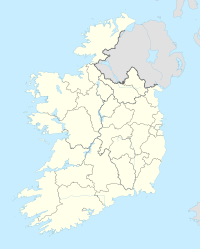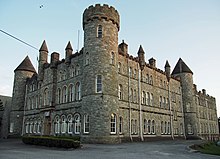Letterkenny
| Letterkenny Leitir Ceanainn Letterkenny |
||
|---|---|---|
|
|
||
| Coordinates | 54 ° 57 ′ N , 7 ° 44 ′ W | |
| Symbols | ||
|
||
|
Motto "Ubique Urbem Reminiscar" |
||
| Basic data | ||
| Country | Ireland | |
| Ulster | ||
| county | Donegal | |
| ISO 3166-2 | IE-DL | |
| Residents | 15,376 (2011) | |
| Telephone code | 074 | |
| Website | www.letterkenny.ie (English) | |
|
View of Letterkenny
|
||
Letterkenny ( Irish : Leitir Ceanainn ) is with 15,376 inhabitants (2011) the largest city in County Donegal, Ireland . The name is an Anglicization of the Irish pronunciation; translated it means "mountainside of the Cannon family".
geography
Letterkenny is located in the far north-west of the Republic of Ireland on the River Swilly , which merges a few kilometers downstream into Lough Swilly and flows into the Atlantic after about 40 km . The city is located 50 kilometers northeast of the city of Donegal and 30 kilometers west of the Northern Irish city of Derry .
history
The current city of Letterkenny dates back to a market town that was founded in the early 17th century during the colonization of Ulster . It could have been built on the site of an earlier Gaelic settlement. Here was the first crossing over the River Swilly . In the more recent past, Letterkenny has been a predominantly agricultural town, surrounded by extensive cattle and sheep pastures on, at the time, undeveloped hill country. At the time, Conwall, only two miles away, was the spiritual and seaport center. The waters of the Atlantic had not yet withdrawn from the River Swilly basin. Its estuary stretched almost to New Mills at the time , evidence of which can be found in the alluvial sand areas between Oldtown and Port Road.
Rory O'Cannon, the last head of the O'Cannon clan, was murdered in 1248. Godfrey O'Donnell succeeded Rory O'Cannon as King of Tír Chonaill. He fought the Normans Maurice FitzGerald , 2nd Lord of Offaly in 1257 at the Battle of Credan in the north of what is now County Sligo , in which both were seriously wounded. Fitzgerald died soon after. Godfrey (also fatally wounded) retired to a crannóg in Lough Beag (Gartan Lake). O'Neill of Tyrone wanted to take advantage of Godfrey's mortal wound and demanded submission, hostages and pledges from the Cenél Chonaill, since they no longer had a strong head. Godfrey gathered his forces and led them himself, although he had to be carried on a stretcher. O'Neill and his men were completely defeated on the River Swilly in 1258. Godfrey died after the battle when he was being carried through town. He was buried in the Conwaller Cemetery. A cross-shaped coffin plate indicates his grave today.
The retreat of the waters of the Atlantic eastward enabled progress and with the construction of bridges etc. the town of Letterkenny began to take on its present form. As a result of the colonization of Ulster, which began around 1609 when the Scottish Patrick Crawford was granted a 4 km² area, the compact settlement was formed.
The honor of formally founding the settlement went to Sir George Marbury, who married Patrick Crawford's widow - Crawford had died suddenly while on a trip to home in Scotland. Originally, there were perhaps 50 simple dwellings on the site of what is now the Old Town ( Oldtown ) is.
The main roads (now suffering from traffic jams) were simple pony trails that were used by the mountain farmers to get to the markets. The markets - founded by Patrick Crawford with just a few animals - have grown into very busy trading centers in the recent past, which they no longer are today.
An old castle stood near what is now the Cathedral of St. Eunan and St. Columba. Letterkenny Castle , built in 1625, was located south of Mount Southwell on Castle Street. The outlaw Redmont O'Hanlon found refuge here in 1690. Today there are no more remains of the castle.
During the Irish Rebellion of 1798 , on October 12, a large French force of 3,000 men, including Theobald Wolfe Tone , attempted to land in County Donegal near Lough Swilly . She was intercepted by a large British Royal Navy force and eventually, after a three-hour battle, defeated without setting foot on Irish soil. Theobald W. Tone was captured and detained at Laird's Hotel (across from Market Square) on Letterkennyer Main Street before being taken to nearby Derry Gaol Prison in Londonderry . He was later tried before a court-martial in Dublin and found guilty. He died of suicide in prison.
In 1824, when the first description of Letterkenny as a modern town was written, it was described as follows: “Within half a mile is the port of Ballyraine, to which ships of 100 tons bring iron, salt and groceries while exporting hides and butter. “There is none of that left today, except for the department stores as examples of 19th century department store architecture.
In 1901 the new Roman Catholic Cathedral of St. Eunan and St. Columba was consecrated and the seat of the diocese of Raphoe was rebuilt here. The diocese - founded in the 6th century - retained its name after the original episcopal city of Raphoe .
Letterkenny received town charter in the early 1920s after the partition of Ireland. When the Irish pound replaced the British pound sterling in County Donegal in 1928 , many Irish banks previously based in Derry, in New Northern Ireland , opened branches in Letterkenny.
In 2008, Letterkenny was the gold medal winner for Ireland in the city category in the prestigious European competition “ Entente Florale Europe ”.
traffic
Letterkenny is also one of the largest bus stations in County Donegal. From here you can travel directly to the capital or take smaller bus companies to the surrounding villages. The bus station is located in the east of the city and is served by “Swilly Bus” in addition to the large Bus Éireann line.
The Irish trunk road N 13 leads from Letterkenny to Londonderry in Northern Ireland , the N 14 to Lifford .
Previously, the city was connected to the narrow gauge network of County Donegal. This allowed connections to Derry, Lifford , Strabane , Gweedore , Burtonport , and Carndonagh . The network was built at the end of the 19th century. After the independence of Ireland, the railway quickly lost its importance due to the new border, and in 1953 it was completely discontinued.
Significant buildings
- St. Eunan's Cathedral
- St. Eunan's College
- Workhouse: City Museum
- St. Conal's Hospital
- Letterkenny Institute of Technology
Daughters and sons of the city
- Sinéad Lynch (* 1976), lightweight rower and track cyclist
- Philip Deignan (* 1983), racing cyclist
Web links
Individual evidence
- ↑ Map of Ireland (can be enlarged greatly) ( Memento of the original from February 21, 2015 in the Internet Archive ) Info: The archive link has been inserted automatically and has not yet been checked. Please check the original and archive link according to the instructions and then remove this notice.
- ^ Donegal News . April 18, 2007.
- ↑ Jim Kelly: Theobald Wolfe Tone. (No longer available online.) In: Ancient Order of Hibernians website, Joseph Duelk Jr. AOH Division 1, Orange County, Monroe, NY, USA. Archived from the original on December 22, 2007 ; Retrieved December 31, 2010 : “Tone was captured at Laird's Hotel in Letterkenny, County Donegal. The site today is known as Letterkenny's Center Spot restaurant. A former fellow student recognized Wolfe Tone, dressed in a French uniform and having breakfast at Lairds. “ Info: The archive link was automatically inserted and not yet checked. Please check the original and archive link according to the instructions and then remove this notice.
- ^ Destination Letterkenny Tourism. In: Website of directorytourism.com. April 27, 2007, archived from the original on September 27, 2007 ; Retrieved on January 1, 2011 : "Nothing remains now except the warehouses, well-maintained, with the typical example of 19century warehouse architecture."
- ↑ Highland Radio - Co Donegal: Letterkenny wins gold medal in Entente Florale ( memento of the original from February 9, 2009 in the Internet Archive ) Info: The archive link was automatically inserted and not yet checked. Please check the original and archive link according to the instructions and then remove this notice. , September 22, 2008






